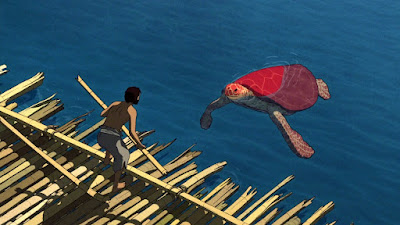WRITER'S NOTE: The following is a collection of reviews posted on my Instagram page @film_freeq. They’ve been organized by their initial release dates.
A very intimate and insightful documentary that chronicles two years with Ghibli co-founder Hayao Miyazaki. Following his publicly-announced retirement in 2013, when he lamented that an era of films made by pencil and paper had reached its end, Miyazaki embarked on an unexpected new project--tackling CGI for a short film called, Boro the Caterpillar--that challenged the "never-ending" creativity and imagination of the legendary filmmaker/animator.
Director Kaku Arakawa makes the wise choice to avoid voice-over narration, instead letting the doc's chapters, subjects, and central merging of old and new techniques (while acknowledging their advantages and disadvantages) speak for themselves. There are also themes of moving forward (and how) in an ever-changing world, recognizing the creative spark that is still there, and the nature of being an artist. This is a worthy successor to Arakawa's superb documentary series, 10 Years With Hayao Miyazaki, and a bit of a sneak preview for Miyazaki's next feature film.
The Red Turtle (2016)
This one technically isn't a Ghibli entry, let alone animé. But it was a rare case (and a first) where the legendary company produced an animated film outside of Japan. A co-production with Sony Pictures Classics, Wild Bunch, and a team of artists based in France, The Red Turtle is a visual, auditory, and spiritual experience.
An update of Daniel Dafoe's novel, Robinson Crusoe, the film initially recalls Tom Hanks on his own deserted island in Robert Zemeckis' Cast Away, as the male protagonist in Michaël Dudok de Wit's film attempts to build a raft and return to civilization. It isn't until the titular sea creature--and eventually a mysterious woman--washes ashore that the story gets more original and engaging.
With parallels to Adam and Eve from the book of Genesis, and a profound and ethereal score by Laurent Perez Del Mar, The Red Turtle is spellbinding, dialogue-free poetry. It's also a challenging piece that blurs the lines between fantasy and reality, with themes of loneliness, mystery, companionship, and family. The result is an affecting and symbolic drama about nature and the cycle of life. What an achievement.
TRIVIAL FACT #1: The Studio Ghibli logo during the opening credits featured a red background instead of its trademark blue.
TRIVIAL FACT #2: In one of his last film credits, Isao Takahata served as artistic producer, while fellow Ghibli co-founder Toshio Suzuki served as co-producer.
Earwig and the Witch (2020)
Studio Ghibli's first film in four years is also their first attempt at a fully-computer-generated feature. Based on the novel by Diana Wynne Jones (Howl’s Moving Castle), planned by Hayao Miyazaki, adapted by Keiko Niwa and Emi Gunji, and directed by Goro Miyazaki, Earwig and the Witch has been met with mixed to negative reception from critics and Ghibli devotees. The story follows an orphaned girl who is taken in by a mysterious couple, forced to do various chores, and soon learns that her mother was a witch.
Set in an English countryside, Earwig has personality and emotion, considering the soundtrack's rock'n'roll vibes. But the CGI is off-putting, and a far cry from what's made Ghibli so wonderful for nearly forty years. It's not exactly uncanny valley territory, but it ironically loses the liveliness and emotional weight of hand-drawn animation (which we do see in the opening and closing credits); only a few scenes (i.e., rain storms, kitchen meals) feel more atmospheric. Add to that some scary (sometimes demonic) images of the adoptive father known as Mandrake, references to potions and spells and voodoo, and a rather disturbing subtext underneath the main song's pop rock beat. Even the titular Earwig pins her hair up like devil horns; something to think about.
TRIVIAL FACT: An earlier (and, perhaps, better) example of this CGI approach is the 2014 Amazon Prime series, Ronja: The Robber's Daughter (directed by Earwig helmer Goro Miyazaki).
***
What we know about Miyazaki's highly-anticipated How Do You Live? so far:
1. It's been in production since 2017, and (according to recent reports) may be released as early as 2023.
2. It's based on a 1937 novel by Yoshino Genzaburo, and is said to be a feature film full of high fantasy and human drama.
3. Miyazaki has stated in interviews that this will be a parting gift for his grandson, although longtime producer Toshio Suzuki believes the legendary animator/director will continue to work as much as he can after this film's completion.








No comments:
Post a Comment